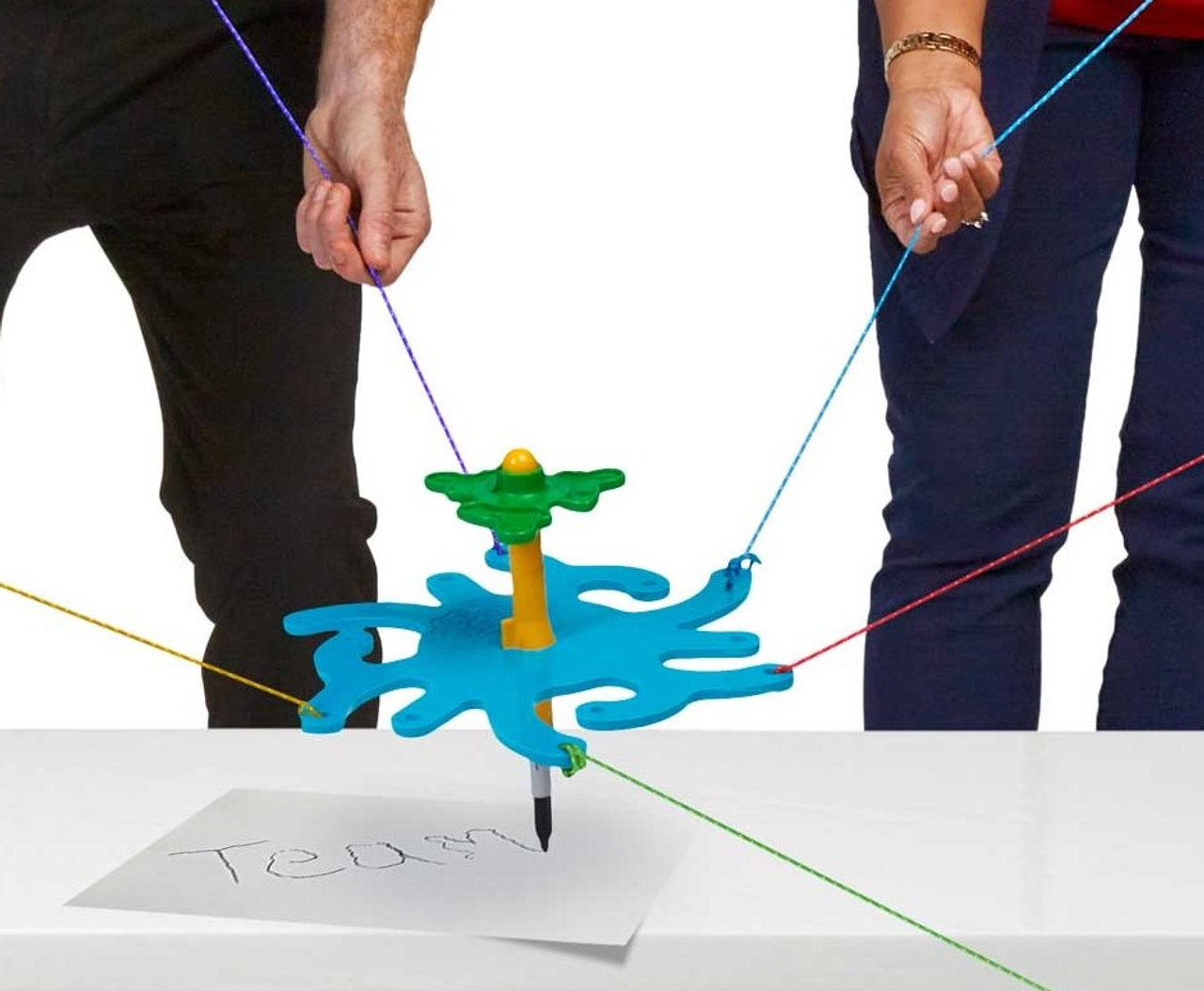How to Select a Team Building Game
With all the team-building games out there–in books, on blogs, facilitated by consultants, and shared in social media–how is one to know what experience is right for their group?
The truth is that too many variables exist for there to be any “right answers.” But, hopefully, we can help you ask the right questions so you’re better able to hone in on a handful of good candidates that will meet your needs.
GOALS
The first question to ask yourself is “What is my goal?” Any game or activity you undertake should have a clear purpose, which should be communicated to participants. Your ability to be completely transparent about the goal will help you get buy-in and participation and will help make the effort a success. To articulate your goal, think about your group in terms of both who they are and how they currently work together–are they just getting to know each other? do they know each other well already? Is there a particular challenge they’re facing?
Try breaking down the goals into these three broad strokes:
- Raise awareness — of issues, personality styles, and roles
- Bring the team together to build relationships — build trust, address problems, improve performance
- Build specific collaborative skills — such as communication, listening, process improvement
No matter the goal, be aware that with most team games, the most important part of the experience is the reflection, learning, discussion, and forward-thinking that happens at the end. As you choose a game, think about the balance of planning time relative to the time taken to complete the task. Your review should address the planning stages of the process, as well as experience of completing whatever challenge you set out.
TIME
Once you have an idea of what you want to accomplish, the next questions relate to time and budget. With respect to time, understand that a more involved, lengthier experience will give more substance on which participants can reflect. In addition, longer debriefs and discussions will allow current work issues to surface and give the group time to work through ways to apply the learning to their day-to-day challenges. While shorter experiences can help to build relationships, awareness, and understanding, they may not get to deeper, underlying issues.
You may wonder if the ultimate goal is to uncover real work issues, then why start with a simulated activity? The reason is that it’s easier for people to make observations and raise concerns in fictional situations than in real ones. But once the topic is broached, people can more comfortably address the ways in which the simulation mirrors the real-world challenges — and discuss new techniques or processes that will yield better results.
BUDGET
Finally, we get to the question of money. We’ve found many team-building experiences both online and in books that won’t cost a penny but may require you to gather props from around the house. If you’re on a low budget or need to travel light, Jim Cain has a series of books that will come in handy (Rope Games, Find Something to Do – no prop activities, and the Big Book of Low-cost Training Games), as does Tom Heck (Duct Tape Teambuilding Games). Sometimes, however, managers and team leaders opt for an experience that signals greater professionalism, planning, and investment. Beyond these perceptions, many pricier games are built on the intellectual property of team-building experts and come with robust facilitation notes.
COGNITIVE CHALLENGE
Consider too the organizational level of your group. For executive teams, you’ll want the challenge of the team-building game to match the complexity of their day-to-day work. If an experience is either too easy or too difficult, you’ll lose the group’s interest.
GAME SELECTIONS
Following are brief descriptions of game choices categorized by goal. The infographic pictured above indicates the required time and relative expense. In addition, these brief descriptions should help you make an appropriate choice for your group.
RAISE AWARENESS of ISSUES, STYLES & ROLES
Helium Stick – Teams try to lower a really lightweight pole without anyone’s finger leaving the pole. Seems easy, but the pole tends to go up, not down. How do teams get in sync?
Team Dynamics Thumball –Discuss the dynamics and interactions of your team. Whoever catches the ball responds to the prompt under their thumb: how do you support each other? show appreciation? gain commitment? build trust? treat mistakes? manage disagreements?
Marshmallow Challenge – Popularized by Tom Wujec, who presented a TED Talk on the subject, the challenge is to build the tallest possible free-standing structure, which will support one marshmallow on the top, using 20 sticks of spaghetti, one yard of tape and one yard of string.
Style Play Cards – 12 quick, energizing games that build awareness of 4 distinct personality styles and let players practice interacting with people of other styles.
Challenging Assumptions – raise awareness of preconceptions as small groups work to assemble a seemingly simple puzzle. They start by turning all the pieces face up and there the learning begins.
BRING TEAMS TOGETHER
TALK ABOUT OUR DYNAMICS
Get to Know Each Other — Thumballs are a great way to discover things about other people. A variety of these balls are suitable for work environments. They’re fun, active, and not intimidating at all!
Team Dynamics Thumball –Discuss the dynamics and interactions of your team. Whoever catches the ball responds to the prompt under their thumb: how do you support each other? show appreciation? gain commitment? build trust? treat mistakes? manage disagreements?
Images of Organizations – The 16 images in this unique pack present a variety of work environments (both positive and frustrating) and will help your group talk openly about difficult topics.
PROBLEM-SOLVE TOGETHER

TeamWRITER® by Trainers Warehouse $42.95 BUY NOW
Matrix Puzzle – Each card in the deck contains one clue. Without writing anything down or sharing their clues, teams need to sort out the logic puzzle and find the solution. The Teamwork & Teamplay Card Deck has one such activity.
Marshmallow Challenge – Popularized by Tom Wujec, who presented a TED Talk on the subject, the challenge is to build the tallest possible free-standing structure, which will support one marshmallow on the top, using 20 sticks of spaghetti, one yard of tape, and one yard of string.
Seeing the Point: This puzzle challenges teams to do more with less. Each is given a set of 7 pieces and asked to create 5 uniform shapes. Creating four of these shapes is easy, but making the fifth takes creativity, out-of-the-box thinking, and the alignment of resources.
TeamWRITER: Teams must work together to position the ropes on a team writing utensil, then draw a picture or phrase, guiding the pen by their ropes..
Pipelines: Give each participant a short length of halfpipe and challenge the group to deliver a ball through the obstacle course without dropping the ball.
DaBridge: Work together to build a DaVinci-style bridge with nothing but a bunch of rods and planks.
PuzzleBlind: Teams collaborate to help blindfolded team members assemble an oversized puzzle.
Perfect Square: For practicing leadership and consensus building, this challenge requires teams to form their 60-foot rope into a perfect square—blindfolded. Generates great discussions about interdependence, communication, leadership, and more.
Construction Kits – construction kits offer oodles of exercises that will let you focus on creative problem-solving, communication, and collaboration skills. Build your own exercise or use one of these Construction Kit Games.
BUILD SKILLS
LISTENING
Workstations – a matrix puzzle, whereby each card contains one piece of information. Without trading cards or writing anything down, team members must share information verbally in order to solve a challenging logic puzzle.
“CO-OPETITION” & NEGOTIATION
T-trade™ involves three groups, each trying to achieve the best business outcome for themselves but needing to ‘make deals’ with other groups in order to be successful. How do they go about making mutually acceptable agreements and yet maintain their focus on achieving the best individual team results they can?
Common Currency — Teams representing fictional countries must cooperate in trading coins and information while competing for the most valuable combination of coins. Interactions involve both task (outcome) and relationship (process) skills. Good for teamwork and strategic planning, leadership, communication, conflict resolution, problem-solving, and decision-making.
COMMUNICATION WITHIN GROUPS
What’s My Communication Style? Uncover preferred styles of verbal and non-verbal communication with a quick personality assessment tool. Discover preferences for one of 4 communication styles and ways to use the styles to enhance communication.
Colourblind – blindfolded participants hold a collection of colored plastic shapes. Teams must work together to identify the pieces missing from the set. Success demands effective group management, questioning, and listening.
Mars Rover: Participants are immersed in a team construction activity, whereby they are tasked by the World Space Agency to build a prototype rover for traversing Mars’ rocky terrain.
COMMUNICATION BETWEEN GROUPS
Seeing the Point — This puzzle challenges teams to do more with less. Each is given a set of 7 pieces and asked to create 5 uniform shapes. Creating four of these shapes is easy, but making the fifth takes creativity, out-of-the-box thinking, and alignment of resources.
Communication Derailed – tackle three common communication challenges (communication within a team, between teams, and during organizational stress). Includes 3 comprehensive modules, each 2-3 hours long.
Minefield – if you don’t want hard-won organizational knowledge to go down the drain this game’s for you. Inter-team communication and cooperation are a must as teams gather costly information to solve this complex logic problem.
UBER-CHALLENGES FOR EXECS
Insight Kit by MTa — MTa Learning’s Insight Kit has 53 different games suitable for team development, problem-solving, communication, leadership, decision-making, and stakeholder alignment. It has a hefty price tag but is worth every penny if you’re looking for highly professional experiences that can be used at any level of the organization. The facilitation and debriefing notes are excellent and will help you select a single game or a sequence of games, depending on your needs.
With so many options, choosing the perfect team-building game may be daunting, but hopefully, these tips and descriptions will help you hone in on the ones that will be best for your group.
- +49
Comments


These are great ideas and I appreciate the thoughtfulness of the groupings. Thank you!